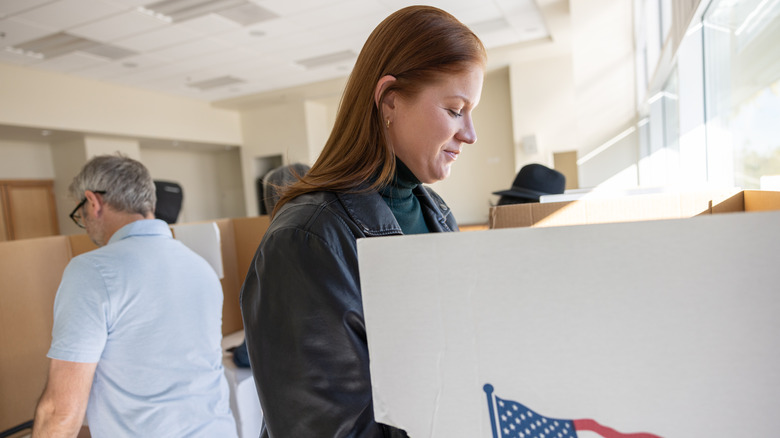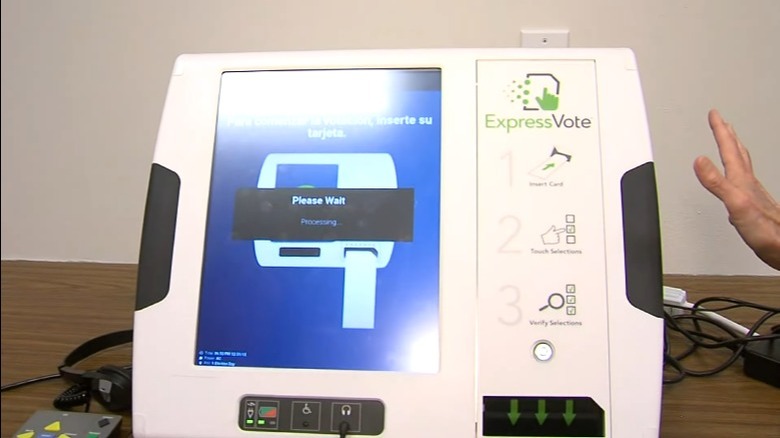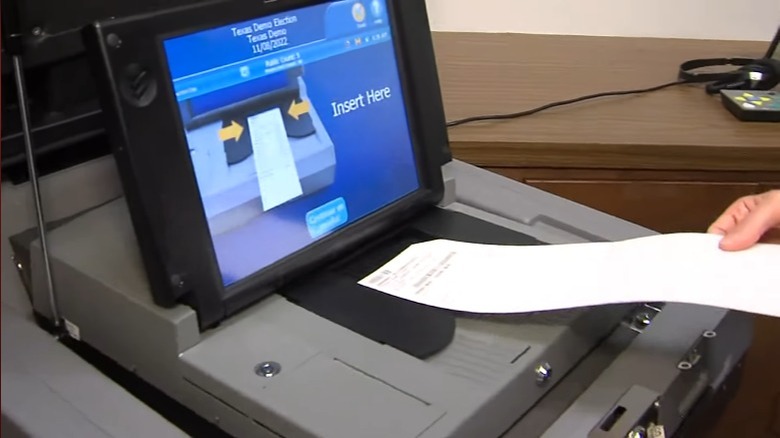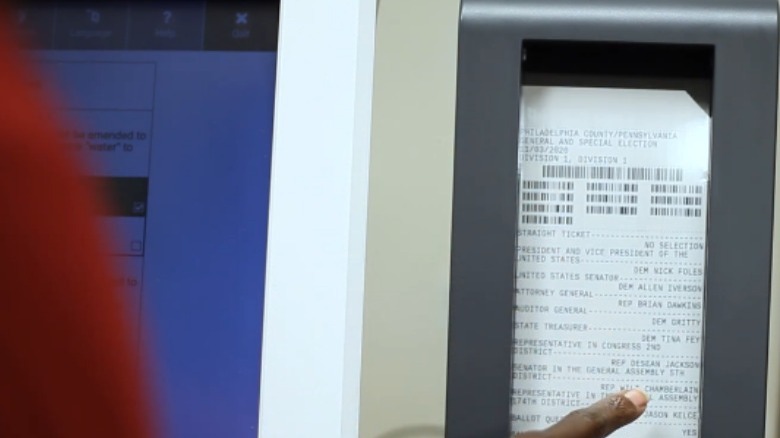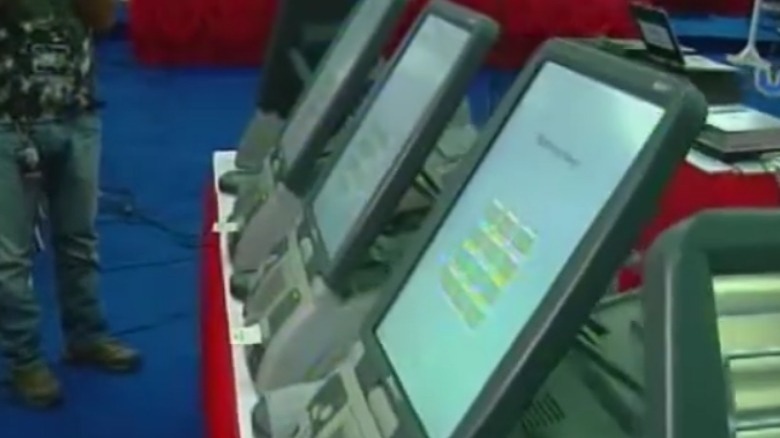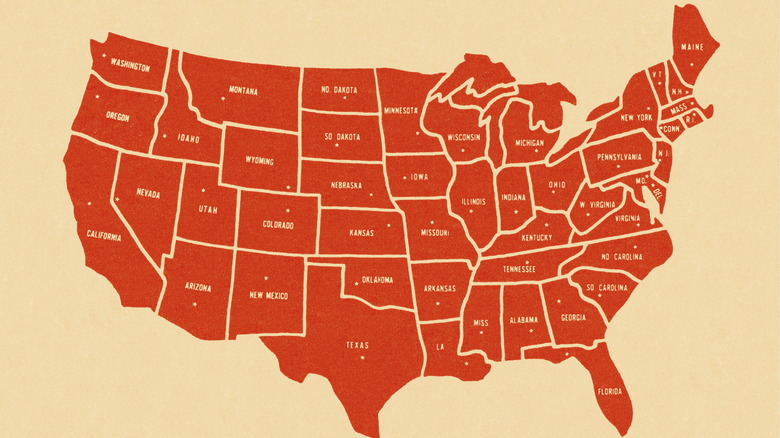Voting Machines: How They Work And How To Use One Correctly
Voting is an important civic duty in the U.S., but it can also be stressful. Each election cycle brings forth new politicians, new legal propositions, and a litany of heated opinions from both major political parties — as demonstrated by Elon Musk's decision to reverse X's ban on political ads and more than a few false claims popping up on YouTube. The burden of responsibility and the uncertainty of change can both feel fatiguing, but luckily, the process of actually voting is fairly straightforward.
States across the U.S. have different voting practices. Some have opted to implement mail-in voting, which allows citizens to vote from the comfort of their own homes, but many exercise their right to vote using voting machines. These are computerized stand-alone units that voters can use to cast their ballot in their local voting center.
These machines play a very important role in the American democratic system, so, understandably, people may wish to learn a bit more about them. How do they work, and how do you use one correctly? There are a few different kinds of machines that can be used in the process of voting. Some of them, like Optical Scanners, are devices that are simply used to tally ballot votes. These may be used in tandem with other voting machines, but Ballot Marking Devices (BMDs) and Direct Recording Electronic (DRE) systems are the ones that most people picture when they think of these machines. Voting machines are made by different companies, so the specific guidelines may vary a bit depending on the make and model you're working with.
Ballot Marking Devices, Hybrid, & Direct Recording Electronic systems
Three different kinds of voting machines are primarily used in the U.S., but what is the difference between them? Ballot Marking Devices are among the most common. These might look somewhat technical, but they're actually pretty simple machines. All they really do is allow you to select your votes from available options and then print your choices on a sheet of paper that can then be submitted to an Optical Scanner to be tabulated. It doesn't record, store, or submit your vote on its own.
Ballot Marking Devices usually have a touch screen or a controller to operate selection. Some machines have braille, voice instruction, and other functions to help individuals with disabilities vote. Ballot marking devices are usually considered among the safest options, as they leave a paper record, and the voter can verify the printed ballot before it's submitted. Hybrid Voting Systems are like Ballot Marking Devices with an Optical Scanner built in. They mark a physical ballot, but the same machine that you used for marking is also responsible for tabulation.
Direct Recording Electronic Systems are entirely digital. These also have a screen that can be controlled either through touch, buttons, or a dial, but they do not print a paper ballot. Instead, they record votes directly into the computer's memory. This skips the step of needing to upload the ballot to an optical scanner. The lack of physical voting records from these machines is a regular source of criticism, and so many of them have Voter Verified Paper Audit Trail (VVPAT) printers that produce a physical record of the digitally recorded vote.
How to use Ballot Marking Devices
Most Ballot Marking Devices are very easy to use. As mentioned previously, there are different kinds available depending on your state and district, but most of them work very similarly. When you get to the polling center, you will need to show a photo I.D., and then one of the workers will give you a blank ballot and direct you to a voting machine. The voting machines will have a place for you to insert the ballot. These often have a corner cut off on the portal, which is designed to match up to the shape of the ballot. Inserting the ballot automatically starts the process on the display.
From there, all you need to do is make your selections on the touchscreen or with the buttons or dial next to the screen if that's what is available. You can usually use the Next and Previous buttons to navigate through the options and menus and then select Review or Print Card options to finalize your ballot. The machine may ask you to verify that you're sure about your selections, and it also may warn you if you've skipped over an option to vote in a specific race. You aren't done using a BMD when the card is printed, however. You still need to verify that all of the choices you made are correct on your printed ballot and then turn it in.
How to use an optical scanner
Optical scanners are considered one of the most accurate and reliable methods of counting votes, and they're fairly easy to use. The stand-alone device has a receptacle for you to slide your filled-out ballot into and is usually about the size of a home printer. These tabulation devices are placed on top of a storage container that holds the ballots after they are scanned. It should be clearly marked at the voting station. Many of them also have screens with visual instructions to help guide you through the process of submitting your vote.
Once you're done using a BMD, simply go to the optical scanner and feed your ballot into the device's portal so that it can tabulate your votes to an internal digital storage device and store your physical ballot in an internal locked box just in case it needs to be recounted later. But while BMDs require the use of a separate optical scanner, this same technology is used in Hybrid Voting Systems' all-in-one units, which is arguably the best solution as it combines the security of a paper ballot with the ease of a digital platform.
How to use Hybrid Voting Systems
Hybrid Voting Systems are voting machines that combine the functions of two voting machines into a single unit. There are three different kinds of HVS: Hybrid Optical Scan/BMDs, Hybrid Optical Scan/DREs, and Hybrid BMD/Tabulators. Some of these are specialty machines that are only available on assistive voting systems, but Hybrid Optical Scan/BMDs are available to general voters in certain areas.
Philadelphia, for instance, has one of these machines. Instructions posted by the City Commissioners state that you should receive a ballot from a voting station employee and take it into the booth. Insert the ballot (cut corner matching the shape of the portal) into the machine. Select your language, choose your voting options using the touchscreen, review your selection, and then cast your ballot. The ballot will then be printed out inside a sealed, clear preview window, allowing you to review your choices and make sure that they have all been recorded correctly.
Up until this point, the instructions have been nearly identical to those you would follow to vote with a BMD. The only difference is that you do not need to remove the ballot from the machine and take it to an Optical Scanner. The scanner is already built-in. Simply select the Vote button on the screen, and the machine will scan the ballot and deposit it safely in the ballot storage container inside the machine.
How to use Direct Recording Electronic Systems
The U.S. has been shifting away from DREs due to the aforementioned security concerns associated with an entirely digital interface. DRE systems are even easier for the voter to interact with, however, since everything is done on a single machine. Like the BMDs, direct recording electronic systems are devices at polling stations that have a screen that will show you your voting options. Many of them are touch screens, but some may have buttons or dials for you to use to navigate through your selections.
Some may even have a keyboard that you can use to write in a vote that isn't listed on the digital ballot. Once you've made your selections, you simply submit your votes on the machine, and they are recorded in the device's internal storage. There are no paper ballots with DRE machines, but the ones that have VVPAT printers will produce a physical record of your ballot, like a receipt, so that you can verify that it was recorded correctly. These records are not ballots that will be recorded themselves, but they are useful if a vote needs to be audited.
Which states use which voting methods?
Most states offer more than one voting method. Some voters may get to choose which voting method they prefer, with differing options being available by district. Google has a useful tool that shows early voting and drop box locations if you aren't aware of your options. The vast majority of states in the U.S. allow voters to either fill out ballots by hand or use a Ballot Marking Device to fill out a physical paper ballot. They then use an Optical Scanner to tabulate and record the votes. This is the most common practice, as it is available in every state in the country except for Oklahoma.
Mail-in voting has gotten more popular in recent election cycles, but it's still one of the least practiced methods in the country by state. California, Colorado, Hawaii, Nevada, Oregon, Utah, Vermont, and Washington are the only states that currently offer mail-in voting.
There are also a few states that use DREs for both voting and tabulation in some of their districts, though. Alaska, Illinois, Indiana, Louisiana, Mississippi, Missouri, Nevada, New Jersey, Ohio, Tennessee, Texas, Utah, West Virginia, and Wisconsin all have these available. Most of the states that use DREs also use VVPAT printers, but not all of them.
